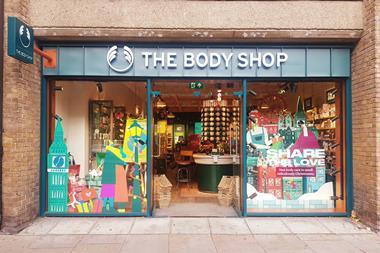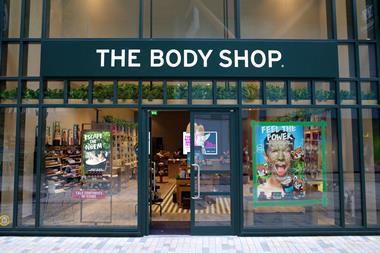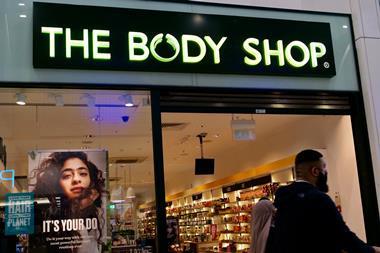As The Body Shop reports dwindling sales in the second quarter of the year, Retail Week takes a closer look at what the bath and body retailer can do to turn the tide
While Brazilian parent company Natura & Co posted an increase in profits for the second quarter of the year, The Body Shop continued to face challenges as its profits took a hit.
In the first full quarter since the arrival of interim chief executive Ian Bickley, The Body Shop reported a gross profit of BRL622.8m (£98.8m), down 11.6% from BRL704.9m (£111.8m) compared with the same period last year.
Net revenue was at BRL800.3m (£126.9m), a 12.5% fall in constant currency terms compared with the BRL909.4m (£144.2m) the business reported in the second quarter of 2023.
After chief executive David Boynton stepped down after six years in the role, the retailer said it was “fundamentally reassessing every aspect of the business” under Bickley’s leadership, including distribution channel rebalance, product optimisation and a focus on structural cost reduction.
Retail Week takes a closer look at the reasons behind The Body Shop’s declining profits and what it needs to do to bounce back.
Why the fall in profits?
Even though Natura & Co offloaded Aesop to L’Oréal in April 2023 to focus its resources on The Body Shop, the retailer has not yet seen that translate in terms of revenue, despite its history and brand image.

Though much of the challenges faced by The Body Shop can be attributed to tough macroeconomic conditions, they also reveal something about consumer behaviour and buying patterns when inflation is at an all-time high and sustainability takes a back seat to personal finances.
Tash Van Boxel, associate retail analyst at GlobalData, says: “The Body Shop’s USP is its own-brand range of skincare and makeup, which is cruelty-free and uses natural ingredients. This particular focus means that, compared with others such as Boots or Superdrug, its starting prices are higher.
“However, we can see from our sustainability index versus personal finances index that when consumers are less able to afford everyday items, the desire to be sustainable diminishes.
“Consequently, The Body Shop is unable to retain existing and attract new customers that are trading down on essential items such as shampoo and cutting back on non-essential purchases including cosmetics.”
For example, in the daily essentials category, The Body Shop’s moisturiser range starts at £7 for 100ml, while Boots sells its own-brand moisturiser for as little as £1.50 for 100ml.
As The Body Shop aims for “stronger optimisation of the product portfolio”, it said its social selling arm, The Body Shop At Home, was a big factor in its latest performance as it “continued to decline sharply as the channel remains weak”.
In fact, the retailer closed the US arm of The Body Shop At Home in March this year, stating “we’ve not seen the market performance that we’d hoped for” and bringing the remaining UK and Australian branches of the business under scrutiny.
What needs to be done?
As The Body Shop looks for ways to come back stronger, focusing on “structural cost reduction and strict cost containment measures” in the short term, British Beauty Council’s chief executive Millie Kendall says it needs to revisit its past and rely more on its strong foundations.
“The brand has a rich history, which I think is often neglected in the brand’s messaging, despite its successful, purpose-driven campaigns,” she says.
“Anita Roddick was a pioneer in the industry and often the brand has let this fact fall by the wayside. Consumers love a brand story these days and this is a clear and unique point of difference for the brand.”
As the retailer reassesses its channels and rebalances its distribution network to meet beauty consumers where they would like to shop, it also needs to build and work on establishing a clear point of differentiation and leverage successful initiatives.

These include its Activist Workshop format, which leans heavily into customers looking to make more informed and sustainable choices, and its subscription service, which appeals to time-short customers.
The Body Shop’s performance isn’t necessarily a good measure of the health of beauty retail in the country as other players in the market continue to perform well.
Boots and Superdrug particularly benefit from strong sales in their own-brand beauty ranges, No7 and Studio London respectively, while The Body Shop’s makeup range has always been a sideshow among its vast spread of bath and body products.
The Body Shop may therefore need to put in a lot more work in the long term to survive in a fiercely competitive beauty market, says Retail Week senior retail analyst Beth Bloomfield.
“The beauty market is fiercely competitive, with new players joining the market as well as stalwarts such as Boots and Superdrug upping the ante when it comes to both their loyalty schemes and own-brand pricing.
“The Body Shop’s competitor Lush has enhanced its proposition over the last few years, both with tie-ups from Super Mario to Barbie and developing a compelling retail environment.
“With the cost-of-living crisis squeezing discretionary spend, consumers may well be downgrading beauty spend on cheaper alternatives.”
As The Body Shop re-evaluates its core business aspects, it needs to find a way to bring its rich history and strong brand image to the fore while also adapting to consumer demands in a rapidly changing market.


























No comments yet